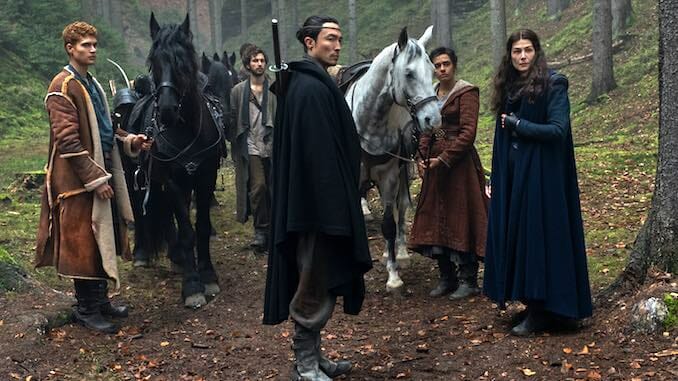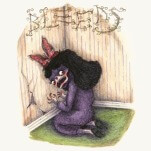4 Ways The Wheel of Time Has Been TV’s Best Chaotic D&D Campaign
Don’t split the party, guys
Photo Courtesy of Amazon Prime Video
Whenever a fantasy television show like Game of Thrones or The Shannara Chronicles airs, connoisseurs will want to know about the usual considerations: Did they get a good cast? What changes are they making to adapt a decades-old series? Did they spend enough on effects to make them look good, and did they write the show well enough that they only use them sparingly? What new spin are they putting on charactersyou already know? And then, there is the most important one: Would it make a good Dungeons & Dragons campaign?
Much of the time, the answer to this last question is a resounding “No.” Game of Thrones, for instance, killed its party leader in the first season and nobody got spell slots until the closing days of the show. As devotees of the much-anticipated Wheel of Time adaptation who also put time into character sheets and too many sets of dice will tell you, Amazon’s retelling of Robert Jordan’s epic series is some absolutely ripping D&D-like drama, sure to elicit chuckles of recognition from veterans of old school dungeon dives and latter-day adherents of the Horny Bard school of character creation. Watching it is a great deal like recounting the exploits of a particularly chaotic campaign with all the glorious highs and ignominious lows that come along with it.
Once you notice it, you won’t be able to ignore it. Spoilers for Amazon’s The Wheel of Time and for every upcoming tabletop roleplaying game session you are about to have follow:
![]()
1. The heroes receive a violent call to adventure (that the Dungeon Master made way too hard).

The first episode has our quartet of Level 1 farmers Rand (Josha Stradowski), Egwene (Madeleine Madden), Perrin (Marcus Rutherford), and Mat (Barney Haris) begin their collective hero’s journey in the only way more common than meeting in a tavern: Having their peaceful, pastoral village totally wiped out by a horde of supernatural monsters in the employ of the Big Bad Evil Guy (“The Dark One,” as he’s called in WoT). As it turns out, one of them may be the reincarnation of an ancient power called The Dragon Reborn, but their mentor/quest-giver, the Aes Sedai mage Moiraine (Rosamund Pike), can’t be sure which of them it might be. The only way to save the world and protect their homeland of Two Rivers is for them to set foot on the long and winding road that leads to the Eye of the World, and a confrontation with ultimate evil.
This is a great foundation episode for the show, setting up internal group conflicts (like when Rand and Egwene are going to get together already), foreshadowing some of the interesting plot developments to come (such as when Rand and Egwene are going to get together already), and raising intriguing character questions (like what do we call a Rand and Egwene ship: “Randwene?” “Egand?”). It is also an episode that bears some of my favorite hallmarks of a chaotic D&D “Session Zero.”
When planning an adventure with your stressed adult friend group, some of whom barely know the rules, a DM can’t be sure who is going to roll what kind of character, nor can they be assured anybody is going to bite on even the most obvious plot hook. That’s why it’s super important to create high-level non-player characters who are ready to lead the adventurers to the next plot point. And when you can’t be sure what kind of abilities your players are going to bring, you need at minimum two kinds of NPC to cover all your bases: Spell Gal and Sword Guy (genders always swappable!) You could not ask for a better interpretation of Spell Gal than Rosamund Pike, who wears her flowing blue Aes Sedai robes with fluid grace, ready to murder monsters with her mystical arts (and political backstabbers with her withering gaze).
But Wheel of Time’s secret weapon, in my opinion, is its Sword Guy. Lan (Daniel Henney) manages to stand out as a top-tier Sword Guy in a year which gave us a second season of The Witcher and Hawkeye’s Jack. The key to a really good Sword Guy is not just whether he is Good at Swords (which Lan absolutely is), but whether he has a deep and soulful backstory (which Lan absolutely does). WoT has its tactical and storytelling bases covered with this dynamic duo, which is just good campaign prep.
But of course, when your DM spends that much time on the framing, they may misjudge how hard to make the encounters. The horde of bestial trollocs that attack Two Rivers in the first episode are way too difficult for fresh characters. In their defense, balancing fights can be tough when you’ve put all your elbow grease into lore and the only time everybody can meet to play is like, a random Wednesday night once a month.
2. Like many rookie players, the heroes come up with tragic backstories, frequently forget their abilities, get cursed, and split the party.

As a “Forever DM,” one of the chosen few who (sadly) know all the rules to D&D and therefore always have to run the game for everybody, it’s impossible not to see some classic rookie behavior in WoT’s core group of four heroes. Obviously it is not a big deal to just let Rand start with a katana if he wants one (we’ll just use longsword stats). Perrin wants to have his backstory be that he killed his wife?? Uh, okay man!
As the show goes on though, some of the character beats are hilariously in line with the sorts of things that happen during games I have run for groups of 13-year-olds. Not long after embarking on their journey, the four main heroes commit the cardinal sin of splitting the party when Lan directs them to take a rest in an ancient ruin. During this same disastrous episode, Mat blithely grabs up magic dagger without bothering to cast Identify on it first, promptly cursing himself. (Moiraine cures him, but only after he’s slogged through the wilderness for a month of in-game time.)
Not long after this, Nynaeve (Zoë Robins) decides to join the game after all, having heard how much fun everybody was having, and immediately wants to know if Lan is a romanceable NPC. When Perrin and Egwene are abducted by the vicious Child Valda and his anti-mage zealots, you can almost hear the DM whispering to the players: “You have spells!! You have animal companions!! Guys!!!” (Both, finally, are used, after some appropriate character development.)
Meanwhile, Rand and Mat are also getting up to exactly the sort of hijinks they shouldn’t when they survive their trek through the wilderness to arrive at a peaceful town with a nice tavern. Mat (who seems to have rolled a rogue with low Charisma), keeps trying to get out of manual labor by attempting to romance the barkeep, and repeatedly fails. Rand, on the other hand, does not fail. In utter despair at the puerile players, the DM loses their patience and announces that the barkeep is actually an enemy. (Rand’s dice are clearly coming up 20s for all the wrong checks, to the chagrin of the DM: He also kicks down an unbreakable door in the very same scene.)
It’s clear these boys have no idea where they’re going or what they’re doing, so in exasperation the DM introduces another NPC guide to bail them out of trouble and get their feet pointed in the right direction, the world-weary Thom, a gleeman (which is what the show call bards). And like the other high-level NPCs, poor Thom only sticks around long enough to get them on the road toward the actual plot.
Splitting up the party is never a good idea, guys.
3. The party must traverse a risky fast-travel dungeon.

Late editions of D&D feature copious amounts of rules about how to adjudicate long overland travel, with all the Tolkien-like twists, turns and potential mishaps such an arduous journey presents. Nobody ever cares about any of that stuff.
When you need to get your group of adventurers from one end of the world map to the other without introducing a rapid system of transit that will simply trivialize all distance in your epic, expansive homebrew world, the obvious solution is the Risky Fast-Travel Dungeon: A portal or subterranean throughway that will get you where you need to go, but is so dangerous that it discourages players from using it every single time they want to go somewhere. The Ways, the creepy chthonic portal system that Moiraine uses to guide the party to within walking distance of the Eye of the World in preparation for the final showdown of Season 1, is a textbook example.
The dungeon crawl is a concept that comes to us straight from Tolkien, of course, and like the Fellowship’s trek through Moria, the journey of our potential Dragons Reborn through the dark dungeon of The Ways is fraught with doubt and danger, and reveals new things about our characters. Except for Mat, of course, who can’t make it to this session and so is left behind as the party enters The Ways. Fortunately for the DM, and for us, this opens up space at the table for Loial (Hammed Animashaun), the more experienced player who has enthusiastically read up on all the lore, and whom our beleaguered DM immediately leans on to help mentor their clueless original party members. Loial is absolutely digging it.
4. The party fights on the front lines of a historic battle for the big showstopper

It’s the end of the campaign. You’ve planned a big finish for your players that is tied in inextricably with their backstories and character motivations, and you’ve managed to get them to the right side of your big rectangular world map in order to participate in it. It’s time for an epic finish: Your adventurers vs. the massed forces of evil!
In the case of WoT, the final episode of Season 1 delivers, as Rand (revealed to be the true Dragon Reborn) joins Moiraine in a desperate mission through the Blight to face The Dark One while the rest of the party hangs back to shore up the defenses of Sheinar, the fortress nation that defends against The Dark One’s encroaching evil. It is also impossible not to read this as a hectic but fun final session in a long-running campaign.
There’s just one problem of course: In addition to Mat’s absence, Rand’s player can’t make it either. The DM handwaves this away by making Rand an NPC who goes to do big important plot things offscreen while the rest of the team participate in a huge, consequential fight that ends—like the best adventures—in charging armies, lightning bolts, and magical mayhem.
If this sounds like I’m making fun of this show, far from it. The Wheel of Time feels like it’s taking a whirlwind tour of what is a much, much larger work, but manages the feat pretty handily, largely by virtue of some good performances and inspired casting. (What could be more like D&D?) Fans of the series, and of a good gaming session, are surely looking forward to Season 2 and all the conflict teased in the finale coming to fruition.
Kenneth Lowe is a regular contributor to Paste Magazine. You can follow him on Twitter and read more at his blog.
For all the latest TV news, reviews, lists and features, follow @Paste_TV.







































